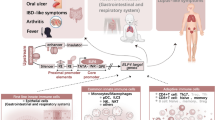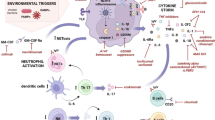Abstract
Objectives
NLRP3-associated autoinflammatory disease (NLRP3-AID) is a spectrum of autosomal dominant inherited diseases associated with NLRP3 gene mutations. Reports of Chinese NLRP3-AID cases are limited to date. In the present study, we aim to describe the phenotype and genotype of a cohort of Chinese adult NLRP3-AID patients
Methods
This single-center study included sixteen adult patients diagnosed with NLRP3-AID at Department of Rheumatology, Peking Union Medical College Hospital from April 2015 to September 2021. Whole-exome sequencing using next-generation sequencing was performed in each patient. Clinical data and mutational information were compared with a European cohort.
Results
The median age of disease onset was 16 (0–46) years old, and adult-onset was observed in 4 patients (25%). The median time of diagnosis delay was 20 (0–39) years. Five patients (31.3%) had family history of similar symptoms. The most common clinical manifestations were recurrent fever (93.8%), arthralgia/arthritis (81.3%), skin rash (75%), myalgia (62.5%), and central nervous system manifestations (50%). Heterozygous NLRP3 variants detected in these patients were p.T348M (n = 4, 25%), Q703K, V70M, K129R, M116I, P38S, V442I, D303G, G326E, A439V, K829T, L632F and V198M (n = 1, separately). All the variants were missense mutations.
Conclusions
We reported the largest case series of Chinese adult NLRP3-AID patients. The distinct symptoms of NLRP3-AID patients suggest the heterogeneity of disease. P38S, M116I, K129R, V442I and K829T were identified as novel NLRP3 variants. These data expand the clinical phenotypic and genotypic profiles of NLRP3-AID.
Key Points • We characterized the clinical and genetic features of sixteen Chinese adult NLRP3-AID patients. • Thirteen NLRP3 gene variants were confirmed in this cohort, and P38S, M116I, K129R, V442I and K829T were identified as novel variants. • Clinical data and mutation information were compared with a European cohort. • We hope these data would expand the phenotypic and genotypic profile of NLRP3-AID and raise the awareness of early diagnosis and accurate treatment among rheumatologists. |


Similar content being viewed by others
Data availability
The original data presented in the study are included in this article. Further inquiries can be directed to the corresponding author.
References
McDermott MF, Aksentijevich I, Galon J et al (1999) Germline mutations in the extracellular domains of the 55 kDa TNF receptor, TNFR1, define a family of dominantly inherited autoinflammatory syndromes. Cell 97:133–144
Broderick L, De Nardo D, Franklin BS, Hoffman HM, Latz E (2015) The inflammasomes and autoinflammatory syndromes. Annu Rev Pathol 10:395–424
De Jesus AA, Canna SW, Liu Y, Goldbach-Mansky R (2015) Molecular mechanisms in genetically defined autoinflammatory diseases: disorders of amplified danger signaling. Annu Rev Immunol 33:823–874
Kuemmerle-Deschner JB (2015) CAPS–pathogenesis, presentation and treatment of an autoinflammatory disease. Semin Immunopathol 37:377–385
Kelley N, Jeltema D, Duan Y, He Y (2019) The NLRP3 Inflammasome: An Overview of Mechanisms of Activation and Regulation. Int J Mol Sci 20:3328
Nishikomori R, Izawa K, Kambe N, Ohara O, Yasumi T (2019) Low-frequency mosaicism in cryopyrin-associated periodic fever syndrome: mosaicism in systemic autoinflammatory diseases. Int Immunol 31(10):649–655
Hoffman HM, Mueller JL, Broide DH, Wanderer AA, Kolodner RD (2001) Mutation of a new gene encoding a putative pyrin-like protein causes familial cold autoinflammatory syndrome and Muckle-Wells syndrome. Nat Genet 29:301–305
Booshehri LM, Hoffman HM (2019) CAPS and NLRP3. J Clin Immunol 39(3):277–286
Koné-Paut I, Galeotti C (2015) Current treatment recommendations and considerations for cryopyrin-associated periodic syndrome. Expert Rev Clin Immunol 11:1083–1092
Almeida de Jesus A, Goldbach-Mansky R (2013) Monogenic autoinflammatory diseases: concept and clinical manifestations. Clin Immunol 147:155–174
Li C, Tan X, Zhang J et al (2017) Gene mutations and clinical phenotypes in 15 Chinese children with cryopyrin-associated periodic syndrome (CAPS). Sci China Life Sci 60:1436–1444
Zhou Y, Wang W, Zhong L et al (2022) Clinical and genetic spectrum of 14 cases of NLRP3-associated autoinflammatory disease (NLRP3-AID) in China and a review of the literature. Orphanet J Rare Dis 17(1):214
Wu D, Shen M (2017) Muckle-Wells syndrome in Chinese patients: a single center case series. Clin Rheumatol 36:965–969
Zhang L, Sun Y, Yu W, Wu D, Shen M, Wang R (2020) Autoantibodies in NLRP3-associated autoinflammatory disease: a case report. Clin Exp Rheumatol 38(Suppl 127):122–123
Liu J, Yu X, Li C, Wang Y, Yu W, Shen M, Zheng W (2021) Behçet’s syndrome in a Chinese pedigree of NLRP3-associated autoinflammatory disease: a coexistence or novel presentation? Front Med (Lausanne) 8:695197
Kuemmerle-Deschner JB, Ozen S, Tyrrell PN et al (2017) Diagnostic criteria for cryopyrin-associated periodic syndrome (CAPS). Ann Rheum Dis 76(6):942–947
Verma D, Särndahl E, Andersson H et al (2012) The Q705K polymorphism in NLRP3 is a gain-of-function alteration leading to excessive interleukin-1β and IL-18 production. PLoS ONE 7(4):e34977
Aksentijevich I, Putnam CD, Remmers EF et al (2007) The clinical continuum of cryopyrinopathies: novel CIAS1 mutations in North American patients and a new cryopyrin model. Arthritis Rheum 56:1273–1285
Dowds TA, Masumoto J, Zhu L, Inohara N, Núñez G (2004) Cryopyrin-induced interleukin 1beta secretion in monocytic cells: enhanced activity of disease-associated mutants and requirement for ASC. J Biol Chem 279:21924–21928
Levy R, Gérard L, Kuemmerle-Deschner J, et al, for PRINTO and Eurofever (2015) Phenotypic and genotypic characteristics of cryopyrin-associated periodic syndrome: a series of 136 patients from the Eurofever Registry. Ann Rheum Dis 74:2043-2049
Toplak N, Frenkel J, Ozen S, et al, Paediatric Rheumatology International Trials Organisation (PRINTO), Eurotraps and Eurofever Projects (2012) An international registry on autoinflammatory diseases: the Eurofever experience. Ann Rheum Dis 71:1177–82
Shwin KW, Lee CR, Goldbach-Mansky R (2017) Dermatologic manifestations of monogenic autoinflammatory diseases. Dermatol Clin 35:21–38
Bertoni A, Carta S, Baldovini C et al (2020) A novel knock-in mouse model of cryopyrin-associated periodic syndromes with development of amyloidosis: Therapeutic efficacy of proton pump inhibitors. J Allergy Clin Immunol 145:368–78.e13
Dodé C, Cuisset L, Delpech M, Grateau G (2003) TNFRSF1A-associated periodic syndrome (TRAPS), Muckle-Wells syndrome (MWS) and renal amyloidosis. J Nephrol 16:435–437
Jesus AA, Silva CA, Segundo GR et al (2008) Phenotype-genotype analysis of cryopyrin-associated periodic syndromes (CAPS): description of a rare non-exon 3 and a novel CIAS1 missense mutation. J Clin Immunol 28:134–138
Hu J, Zhu Y, Zhang JZ, Zhang RG, Li HM (2017) A novel mutation in the pyrin domain of the nod-like receptor family pyrin domain containing protein 3 in muckle-wells syndrome. Chin Med J (Engl) 130:586–593
Matsubayashi T, Sugiura H, Arai T, Oh-Ishi T, Inamo Y (2006) Anakinra therapy for CINCA syndrome with a novel mutation in exon 4 of the CIAS1 gene. Acta Paediatr 95:246–249
Cuisset L, Jeru I, Dumont B, et al, French CAPS study group (2011) Mutations in the autoinflammatory cryopyrin-associated periodic syndrome gene: epidemiological study and lessons from eight years of genetic analysis in France. Ann Rheum Dis 70:495–459
Kreft B, Schlinsog AS, Wohlrab J (2018) Cryopyrin-associated periodic syndrome (CAPS) in a patient with NLRP3 T348M mutation. J Dtsch Dermatol Ges 16:1266–1268
Kuemmerle-Deschner JB, Koitschev A, Ummenhofer K et al (2013) Hearing loss in Muckle-Wells syndrome. Arthritis Rheum 65:824–831
Parker T, Keddie S, Kidd D et al (2016) Neurology of the cryopyrin-associated periodic fever syndrome. Eur J Neurol 23:1145–1151
Qin W, Wu D, Luo Y et al (2020) Neurological manifestations of autoinflammatory diseases in Chinese adult patients. Semin Arthritis Rheum 50:1500–1506
Meng T, Wu D, Luo Y, Wu N, Zhao M, Shen M, Yu W (2021) Ocular manifestations in Chinese adult patients with NLRP3-associated autoinflammatory disease. Sci Rep 7(11):11904
Georgin-Lavialle S, Ducharme-Benard S, Sarrabay G et al (2020) Systemic autoinflammatory diseases: Clinical state of the art. Best Pract Res Clin Rheumatol 34:101529
Szekanecz Z, McInnes IB, Schett G et al (2021) Autoinflammation and autoimmunity across rheumatic and musculoskeletal diseases. Nat Rev Rheumatol 17:585–595
Acknowledgements
We would like to acknowledge all the patients for their consents to participate in the study.
Funding
This work was supported by the Natural Science Foundation of Beijing (Grant No.7192170); the Chinese Academy of Medical Sciences Innovation Fund for Medical Sciences (CIFMS) (Grant No.2017-I2M-3–001); the National Key Research and Development Program of China (Grant No.2016YFC0901500; 2016YFC0901501); and the National High Level Hospital Clinical Research Funding (Grant No.2022-PUMCH-D-002; 2022-PUMCH-B-013).
Author information
Authors and Affiliations
Corresponding author
Ethics declarations
Conflict of interest
The authors declare no conflict of interest.
Additional information
Publisher's note
Springer Nature remains neutral with regard to jurisdictional claims in published maps and institutional affiliations.
Rights and permissions
Springer Nature or its licensor (e.g. a society or other partner) holds exclusive rights to this article under a publishing agreement with the author(s) or other rightsholder(s); author self-archiving of the accepted manuscript version of this article is solely governed by the terms of such publishing agreement and applicable law.
About this article
Cite this article
Wu, N., Wu, D., Miao, J. et al. The phenotype and genotype of Chinese adult patients with NLRP3-associated autoinflammatory disease. Clin Rheumatol 42, 2841–2848 (2023). https://doi.org/10.1007/s10067-023-06679-5
Received:
Revised:
Accepted:
Published:
Issue Date:
DOI: https://doi.org/10.1007/s10067-023-06679-5




